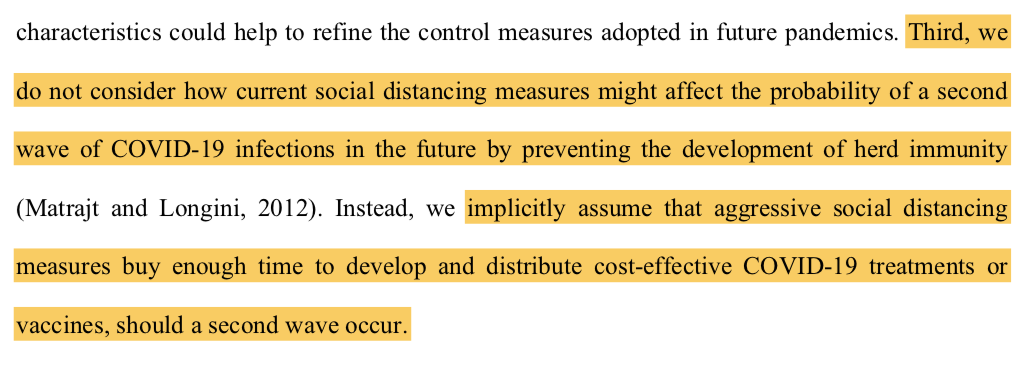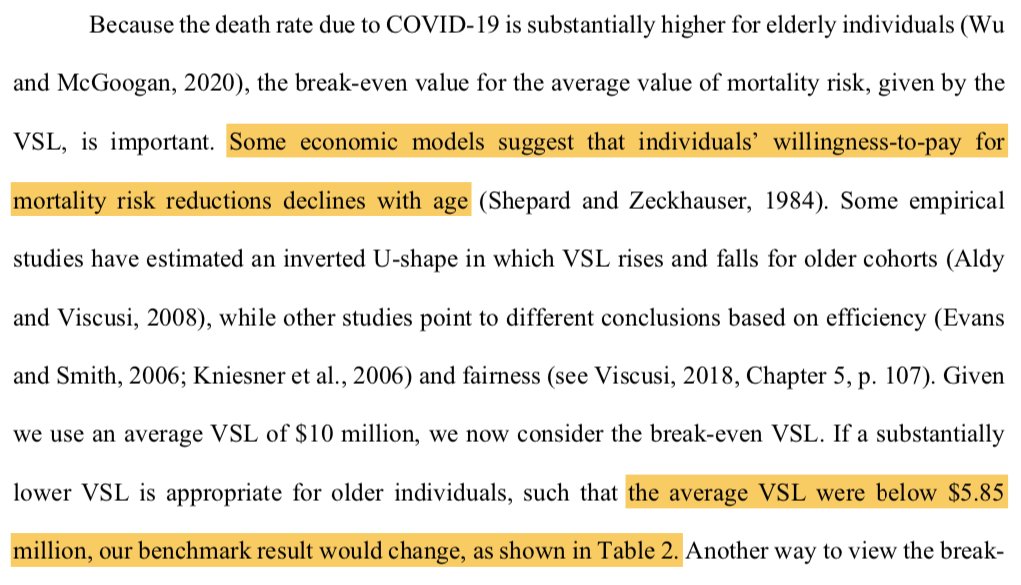Economic analysis from @ThunstromLinda and colleagues shows the benefits of social distancing outweigh the economic costs by $5.2 trillion
(Paper available here: https://papers.ssrn.com/sol3/papers.cfm?abstract_id=3561934)https://papers.ssrn.com/sol3/pape... href=" https://thehill.com/policy/finance/economy/492946-benefits-social-distancing-outweigh-GDP-losses-by-5.2-trillion-analysis">https://thehill.com/policy/fi...
(Paper available here: https://papers.ssrn.com/sol3/papers.cfm?abstract_id=3561934)
This fundamentally tells us that doing *some social distancing* is better than doing nothing
I think this is correct — here is their basic illustration of cost paths
However, I& #39;d like to highlight one major concern and some interesting points
I think this is correct — here is their basic illustration of cost paths
However, I& #39;d like to highlight one major concern and some interesting points
The analysis ignores 2nd wave — what happens after we have successfully reduced infections in the first wave
It just assumes that there will be treatment or vaccine for the 2nd wave arriving in the fall
This could dramatically underestimate the cost of strong social distancing
It just assumes that there will be treatment or vaccine for the 2nd wave arriving in the fall
This could dramatically underestimate the cost of strong social distancing
We know from Spanish Flu a century ago that social distancing is effective, but "overeffective" policies (too strict lockdowns) are less effective because they drive a second wave
This cost-benefit analysis misses the costs of "too effective" lockdowns
https://www.pnas.org/content/104/18/7588">https://www.pnas.org/content/1...
This cost-benefit analysis misses the costs of "too effective" lockdowns
https://www.pnas.org/content/104/18/7588">https://www.pnas.org/content/1...
Beyond that, the paper does great sensitivity
It estimates a GDP cost from social distancing of 6.2% in first year.
If the actual GDP cost is higher than 8.5% of GDP in first year, it turns out that social distancing policies led to an overall *worse* outcome for the US
It estimates a GDP cost from social distancing of 6.2% in first year.
If the actual GDP cost is higher than 8.5% of GDP in first year, it turns out that social distancing policies led to an overall *worse* outcome for the US
Corona and climate are exactly opposite in cost and benefit streams:
With corona, the benefits are upfront, and costs are longterm in lower GDP over next decades
Indeed, if the planning horizon is longer than 63 years, current social distancing leads to worse outcomes
With corona, the benefits are upfront, and costs are longterm in lower GDP over next decades
Indeed, if the planning horizon is longer than 63 years, current social distancing leads to worse outcomes
Finally, given that most corona victims are old, it is worth considering whether $10 million per VSL is correct. Indeed, if value of saved life is less than $5.85m, social distancing leads to worse outcome
US HHS estimate a life-year saved worth about $500K ( #page=26">https://aspe.hhs.gov/system/files/pdf/242926/HHS_RIAGuidance.pdf #page=26),">https://aspe.hhs.gov/system/fi... and with 7.8 life years saved per corona case ( https://theincidentaleconomist.com/wordpress/economic-cost-of-flattening-the-curve/),">https://theincidentaleconomist.com/wordpress... that suggests a benefit of about $3.8m per life, meaning that social distancing delivers worse outcomes
The paper is very interesting and well done. It shows us that while there is definitely many benefits to be had to "flattening the curve", lock-down policies are easy
We need to make sure the lock-down policies keep infections below capacity and also are as low-cost as possible
We need to make sure the lock-down policies keep infections below capacity and also are as low-cost as possible

 Read on Twitter
Read on Twitter







